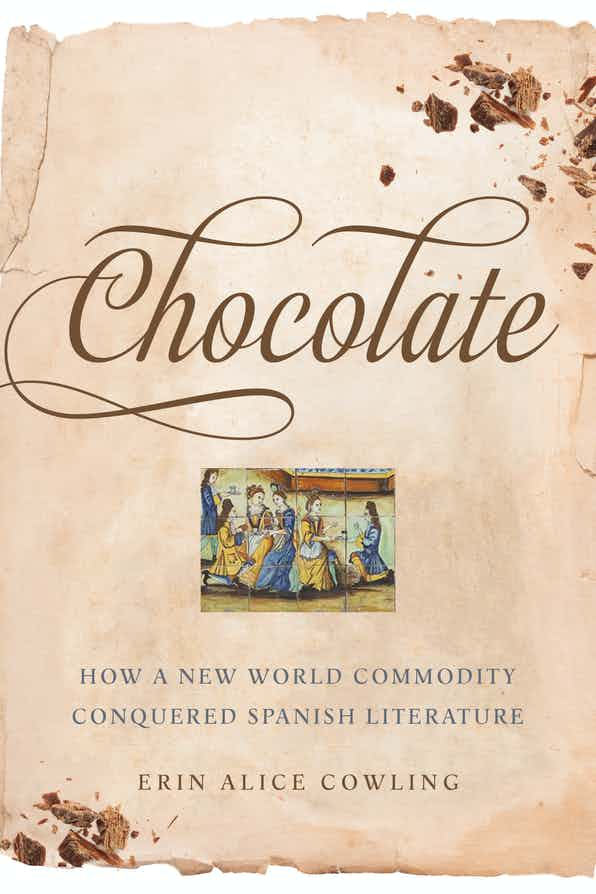Cowling, Erin Alice. Chocolate: How A New World Commodity Conquered Spanish Literature. U of Toronto P, 2021.

Do you like chocolate? Do you prefer to drink it? Or, do you prefer to eat it piece by piece to make it last as much as you can? Can you feel how the taste takes over your mouth? Can you imagine the smell? Can you feel the texture? Are you craving chocolate as you read these words?
Chocolate is one of those pleasures that make our lives better.
Chocolate takes us back to our childhood when we used to eat sweets without worrying about the consequences. It reminds us of our younger years when friends and secret admirers used to give us a box of Ferrero Rocher or Russell Stover on St. Valentine’s Day. It evokes the feeling of warmth when we drink it in front of a fireplace on a winter day.
We love chocolate.
Yet, we hardly stop to think about the discourses around chocolate until a book written by Erin Alice Cowling invites us to reflect on how chocolate appeared in Spanish literature in Chocolate: How A New World Commodity Conquered Spanish Literature.
This beautiful text guides us through the first encounters of Spaniards with chocolate in the Americas, how it became popular in Spain once it made its way through commerce, the reaction of the Church and debates on fasting, the medical discourses around it, and the condemnation of the sinful nature of the cacao bean. Cowling examines poems, plays, medical treatises, religious debates, and divorce cases to explore how chocolate is represented and constructed in literature. This repertoire illustrates that there is not a unified perspective about chocolate and the reactions it produced since the fifteenth century are contradictory as its use, flavors, and shapes.
Chocolate and Commerce
Originally from the Americas, chocolate came to Europe after Christopher Columbus crossed the Atlantic. Since then, chocolate has appeared in writings that range from historical documents to literary ones. Cowling divides these writings into five categories:
- cacao bean as currency
- the use of the drink in ceremonies and as a gift
- the cultivation of cacao trees and processes of creating the drink
- its use as a health supplement by the Indigenous peoples and consequent implications for the health of Spanish citizen
- the religious implications of drinking chocolate during the fast
Cowling collects views of conquistadors and chroniclers like Hernán Cortés, Bernal Díaz del Castillo, and Motolinia and how they described it and sometimes vilified it. These early writings illustrate the fascination produced by chocolate and the different attempts to understand its uses and effects.
Once exported, chocolate shaped the Spanish economy. According to Cowling, during the early days chocolate was reserved to nobility and the wealthy (44). Spaniards who spent years in the Americas and returned to Spain with a fortune were connected with chocolate in literary sources. The connection between these indianos and chocolate was a reminder that chocolate represents “Otherness.” Within a century, chocolate became a symbol of status.
Chocolate and the Church
Once chocolate became popular in Spain, religious figures tried their best to understand how chocolate fits within the Church. Cowling examines sources concerning the debate of chocolate and fasting. Does chocolate break it? Is a food? Is a drink?
Cowling presents testimonials from both sides. Chocolate was viewed as something to be avoid during fasting, and, at the same time, something allowed to put in the body. She brings the example of Agustín Moreto’s Santa Rosa del Perú (1660’s) and analyzes the food symbolism. From this play, Cowling goes from the fasting practice to the erotic qualities of chocolate as it was considered a purported aphrodisiac.
Chocolate and Medicine
Cowling explores the medicinal effects of chocolate. One of the debates was to decide if chocolate was healthy or not. The main point made in these discussions is that additional ingredients are the ones to blame.
During the seventeenth century, writers tried to determine the effects of chocolate in pregnant women. Some believed that chocolate might potentially contribute to a stillbirth (120). Later, in the eighteenth century, chocolate was used as stomach balm.
Chocolate and Sin
The fascination with chocolate does not protect it from writers who condemned it for inducing people to commit deadly sins. According to Cowling, sources show that chocolate was connected to three of the capital vices: greed, gluttony, and lust.
This is a delicious book! It is beautifully written, carefully organized, and meticulously documented. Readers will enjoy and learn from it.
In summary, this book…
- provides a historical, legal, and literary context of chocolate in Spain.
- explains how chocolate came to Europe and how it shaped the economy.
- explores the religious debates surrounding chocolate and fasting.
- examines how sources address the medicinal effects of chocolate.
- invites us to reflect on the “sinful” nature of chocolate and its connection to deadly sins.
I want to finish this post with two recommendations.
First, I would like you to start reflecting on chocolate:
- What memories does chocolate evoke in you? Thoughts?
- How much do you know about chocolate? its history? its uses? its effects?
- What can we learn from literary representations of chocolate?
Second, I would like that you read this book:
- Can you buy it for your personal library?
- Can you convince a librarian to add the book to the university or local library?
- Can you ask someone to buy it for you as a gift?
This book review includes a link as part of the Amazon Affiliate Program. As an Amazon Associate, I earn a commission from qualifying purchases.
